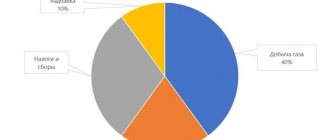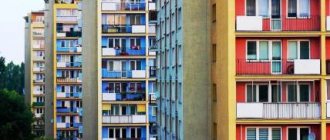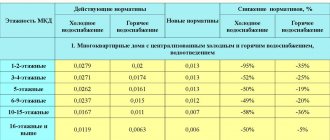Article 20
1. Residents of the city of Moscow who are recognized as being in need of improved housing conditions, recognized as being in need of residential premises, are provided with residential premises from the housing stock of the city of Moscow, the area of which is not less than the provision norm, except for the cases provided for by this Law.
Determination of the size of the area of residential premises to be provided is made taking into account the level of provision of citizens on the housing register with the area of residential premises, determined in accordance with Part 1 of Article 9 of this Law. 7. Families that include patients suffering from severe forms of certain chronic diseases, the list of which is established by federal legislation, are provided with living quarters that allow such persons to be allocated a separate isolated living space in an apartment for the use of such persons. Requirements for the provision of additional space are not subject to satisfaction if these persons can be provided with a separate isolated living space in the apartment.
Commentary on Article 50 of the RF Housing Code
1. The need for housing is one of the conditions for providing housing to citizens under a social tenancy agreement. To determine need, in particular, the concept of “accounting standard for living space area” is used. Thus, tenants of residential premises under a social tenancy agreement, as well as home owners, are recognized as needing residential premises if the total area per family member is less than the accounting norm (see commentary to Article 51).
The accounting norm is established by the local government body. According to the previously existing Housing Code of the RSFSR, the accounting norm was established by the constituent entities of the Russian Federation (Clause 1, Article 29), as well as the provision norm (Article 40).
2. Under a social tenancy agreement, residential premises are provided with a total area per person not less than the provision norm established by the local government depending on the achieved level of provision of social housing in a given locality.
It is obvious that local governments must also take into account the types of residential premises, the composition of families registered as needing residential premises, etc.
The provision standard in accordance with Part 1 of the commented article is the minimum size of living space that must be allocated to each family member. Based on this norm, the size of the total area of provided housing is determined.
As for certain categories of citizens (see paragraph 4 of the commentary to Article 49), then for them federal laws, decrees of the President of the Russian Federation, and laws of constituent entities of the Russian Federation may establish other standards for provision.
In addition, for these categories of citizens, federal laws, decrees of the President of the Russian Federation, and laws of constituent entities of the Russian Federation may establish other accounting standards.
3. In accordance with Part 5 of the commented article, the size of the accounting norm should not exceed the size of the provision norm. That is, paradoxically, it is possible that they coincide in size.
4. The Federal Law on the enactment of the Housing Code of the Russian Federation recognizes the importance of the “norm for the total area of living space per person.” Its necessity is indicated by Art. 679, 680, 685 of the Civil Code of the Russian Federation, which are amended accordingly (see Article 11). However, this concept is not used in the RF Housing Code.
Registration norm of living space per person
How much is the standard living space per person? It is important for every citizen to know this information, since otherwise it will not be possible to resolve the issue regarding the division of living space, determining the order of resettlement, resolving a conflict situation regarding the division of an object, etc.
- if the apartment transferred for disposal under a social tenancy agreement is located in a building awaiting major renovation;
- if the living space was confiscated from a person for debts to a banking organization due to non-payment of mortgage interest, and in other situations;
- the only place to live was lost due to an emergency.
About the accounting norm
The provisions of accounting standards are described in 50 articles of the Housing Code. The predominant standard indicator is 18 m2, but it is possible under certain circumstances to increase it:
- provision of one room,
- allocation of a one-room apartment,
- the presence of a severe stage of disease (chronic forms).
Persons employed in internal organs (minimum rank - colonel) and persons with merit in the field of science can also count on an increased rate. But the increased figure never exceeds two norms (36 m2 as of 2018).
Registration forms establish the minimum value of living space per person. Based on the indicator, families who are eligible for the program to improve the quality of living are determined.
What is the standard living space per person?
For most Russians, the housing issue remains the most difficult and pressing. Many are trying to resolve the situation with an insufficient number of meters for normal and comfortable living in various ways. Often you have to resort to mortgage lending. But not everyone can afford to purchase housing using their own and borrowed funds. In some cases, government assistance is necessary. And here a logical question arises: how many square meters of living space is assigned to each person?
The size of the transferred housing under a social tenancy agreement is subject to regional standards, but may be higher than them. The contract is concluded for five years, and then transferred to personal use. Orphans are necessarily allocated separate housing, which is a comfortable apartment or house.
How many meters of living space are allowed per person?
The standard living space per person is subject to mandatory accounting when issuing municipal housing. How many meters a citizen and his family are entitled to is decided when studying the technical documentation for the living space. In Russia, federal standards have been defined, which, according to Art. 38 Housing Code of the Russian Federation is 12 m per person. But regional authorities have the right to adjust this norm.
We recommend reading: Disabled children in Russia
Situations are possible when a young family is denied improved housing conditions, since the total area of their property is higher than the accounting indicators. Administration specialists often do not take into account the fact that the living area of an apartment or private house is much smaller than the total.
Social norm of square meters per person in 2021 in Moscow, standards
- 44 m 2 - two persons in a legal relationship;
- 50 m2 - for two people who are not related to each other;
- 62 m2 - family consists of 3 people;
- 74 m2 - accommodation for 3 people without family ties;
- 18 m2 - for each person, family of 4 people or more.
- provision: applies when housing is transferred under a social rental agreement, as well as under certain circumstances, which may be mortgage debt obligations, damage to previous housing due to a natural disaster, etc.;
- accounting: used when it is necessary to find out how many square meters should be allocated to one person when improving the quality of living (changing living conditions);
- social: applied to allocated subsidies, including the payment of utilities.
- sanitary standards: the value does not fall below 6 m2 per resident, relevant when allocating living space in a dormitory.
How many square meters per person in 2021
When figuring out how many square meters are allocated per person in an apartment, you need to take into account that the calculations depend on a whole list of factors. The living conditions in a specific subject of the Russian Federation are taken into account, as well as the calculation of which specific norm is being met.
The concept affects the number of people who can live in the premises, as well as the ability to claim additional meters. Not everyone can improve their living conditions. The list of persons who have such a right is reflected in the current legislation. We will talk further about the rules in accordance with which citizens are given additional premises, the amount of standards in accordance with which a person can apply for improved living conditions, as well as who is provided with housing benefits.
Standard housing area per person
When calculating the indicator of need, persons permanently and temporarily registered in residential premises should be taken into account, but it is prohibited to register citizens in order to reduce the minimum size of living space per person. This can be considered a deliberate deterioration of living conditions.
- citizens who have been awarded three degrees of the Order of Glory - an additional 15 sq. m;
- federal judges – receive an additional 20 sq. m;
- full holders of the Order of Glory, Heroes of the Russian Federation and the USSR - receive an additional 20 sq. m;
- employees of the Investigative Committee of the Russian Federation - additional 20 sq. m;
- judges of the Constitutional Court of the Russian Federation - additional 20 sq. m;
- military personnel with the rank of colonel and general, commanders of military units, military personnel with a registration degree - 16-25 sq. m.
Types of living space standards
All existing types of living space standards are regulated by the Housing Code of the Russian Federation. These indicators are used to calculate the living space suitable for living. Let's look at them in the table below.
| No. | Criterion | Description |
| 1 | Provision rate | When signing a social rental agreement, the minimum number of square meters per person is considered. In many regions this figure is 18 sq.m. area. This is the minimum calculated value, increased by allocating a room or one-room apartment |
| 2 | Accounting norm | The minimum living space that is taken into account to recognize a family as one that needs to improve their living conditions. Indicators that help identify the need to expand a property to be placed on the waiting list. All citizens who are registered in the residential premises participate in this calculation. But it will not be possible to register an uncontrolled number of people to obtain an increase in living space. This norm is prescribed in Article 50 of the RF Housing Code |
| 3 | Social norm | The norm applicable when establishing subsidies for housing and payment for housing and communal services |
| 4 | Sanitary standard per person | The minimum sanitary standard for living space is 6 m2 per person |
Let's look at an example. The Petrov family, consisting of four people, lives in a one-room apartment under a social rental agreement. In 2021, this family welcomed a third child and the provision rate decreased. Father Petrov A.P. decides to expand the living space and applies to the Social Security Administration with an application to improve their living conditions.
Standard living space per person in 2019
The social norm is the norm that is required when calculating utility bills. It is different in each region. In general, it is 18 m2, but more often it is increased depending on how many citizens simultaneously live in the apartment and what gender they are.
- If necessary, confirm the tenant’s right to receive additional space.
- For the settlement of temporary residents (renting out housing);
- Relocation of a tenant during a major renovation of a building. The real estate property is being divided.
- When a tenant is evicted from his living space.
- When calculating payment for living space.
We recommend reading: Register of pledged real estate, notary chamber
What living space standards are used in 2019
Legislative bodies may review the grounds on which a person can be placed in a flexible fund. If the apartment was taken away for debts, government authorities may provide the debtor with a temporary place of residence to pay off the debt.
- Minimal. The minimum is typical for residents of hostels and shunting funds.
- Provision rate. We are talking about the allocation of living space to a citizen through the conclusion of a social tenancy agreement.
- The accounting area must exceed the provision norm in area. It determines whether the state is obliged to provide more living space than a large family owns or not.
How many square meters of living space are allowed per person?
Classic standards: 18 square meters per citizen, 42 square meters for a family of two, 33 square meters for those who live alone . And enters into a social rental agreement. According to the norm, one person should receive at least 12 squares . But this is only relevant for those who are recognized as in need of improved housing conditions.
- If there is one tenant living alone, he is allocated an area equal to 33 square meters .
- 42 squares is the minimum required for two people.
- If a family consists of three people, then each of them should receive at least 18 squares . But in any case, they must receive at least 16 squares at their disposal .
Living space standard
Compliance with regulatory criteria allows you to turn to the state to increase the area and obtain housing. It is mandatory for privatization, divorce proceedings and division of acquired property. Necessary for applying for benefits and subsidies for utility bills. They are referred to when deciding the issue of resettlement from dilapidated houses.
Based on the above, at least 18x3 = 54 m2 of total area is required for 3 people. With values below, you have the right to be provided with an apartment with the appropriate square footage. If 2 family members and 1 stranger, but registered, live in the room, the range expands: 54-62 m2. In the case of 3 unauthorized persons, boundaries are set from 62 to 74 square meters. m. Those living in the amount of 5 people need an area of 18x5 = 90 m2.
Social norm for living space per person
Any person who has passed this path needs to prepare for a long wait, which does not always end in success. After all, in our country there are a lot of low-income families who are entitled to free housing space from the state, but there is very little of this kind of housing.
In some cases, the municipality is not able to provide a family with adequate housing, so they are moved into temporary housing or a hostel, observing sanitary standards. If the relocation occurs in accordance with municipal regulations, then the family can be moved to an apartment that is smaller than the required area, but at least ten square meters must be allocated per person.
Types of norms
Indicators for accommodation can be divided into different types. Each type has its own separate terms of use.
The following types are distinguished:
- Residential squares provided in accordance with the rental agreement (provision rate)
- Accounting size of living space
- Social norm
- Sanitary area of housing.
Minimum sanitary standard
This concept is most often used for those types of housing that are temporary. This means living in dormitories, barracks and communal apartments.
Good to know! The concept characterizes the necessary standards for the personal space of a living person, for example, the height of ceilings and the presence of a certain number of windows. The required size of such housing is at least 6 square meters per person.
Accounting norm
It is used to record the availability of those categories of citizens who need improved living conditions and who can apply for additional living space. According to standards, the minimum size of the accounting area per living person is at least 12 square meters. meters.
Let's celebrate! If the family has low-income status and has a living area of up to 14 sq. meters per person, the law provides for the possibility of registering for improved housing.
Presentation norm
It consists of the available minimum area for housing per person when concluding a rental agreement for residential premises. An area of this type must be at least 18 square meters in size. meters.
In case of violation of norms, this may be considered as an infringement of the rights of users of residential space. And may incur administrative penalties.
How many square meters are allowed per person - living space standards
Good afternoon. We are expecting a third child, we want to receive a plot of land (or monetary compensation). But it turned out that they do not give it to everyone, but only to those who do not have enough square meters. We have a mortgage of 64 sq. We live in the Khanty-Mansi Autonomous Okrug, Nefteyugansk. Tell me how many squares are allowed per person.
Hello Anna! The law of the city of Moscow establishes a registration standard for the area of residential premises, on the basis of which citizens can be registered as those in need of residential premises. So, this norm in the city of Moscow is 10 sq.m. total living space per person. Thus, the area of your apartment for the three people registered in it does not allow you to register as those in need of housing.
Accounting standard for residential area in the Leningrad region
The accounting norm in the Leningrad region is set at 9 to 12 square meters. m. (and 15 sq. m. for a communal apartment) depending on the territory.
The dimensions of the accounting standard for the area of residential premises, established by decisions of the legislative bodies of local self-government of the Leningrad region using the example of some municipalities:
- Sosnovy Bor city, Leningrad region - 12 sq. m. of total area per person (Decision of the Meeting of Representatives of the Municipal Formation “City of Sosnovy Bor” of the Leningrad Region dated March 28, 2005 N 35 (as amended on October 28, 2008);
- Boksitogorsk urban settlement of Boksitogorsk municipal district of Leningrad region - 9 sq. m. and less than the total area of living space per person (Decision of the Council of Deputies of the municipal formation Boksitogorsk urban settlement of the Boksitogorsk municipal district of the Leningrad region dated February 22, 2006 N 34);
- Volosovskoye urban settlement of the Volosovsky municipal district of the Leningrad region - 9 sq. m. (Decision of the Council of Deputies of the municipal formation Volosovskoye urban settlement of the Volosovsky municipal district of the Leningrad region dated February 16, 2006 N 33);
- Volkhov city, Leningrad region - 9 sq. m. of total area per person (Decision of the Municipality of the city of Volkhov, Leningrad Region dated October 4, 2005 N 38);
- city of Vsevolozhsk - 10 or less square meters. m. of total living space per person (Decision of the Council of Deputies of the municipal formation “City of Vsevolozhsk” of the Vsevolozhsk municipal district of the Leningrad region dated May 26, 2020 N 27);
- Vyborg urban settlement, Vyborg district, Leningrad region - 9 sq. m. (Decision of the Council of Deputies of the municipal formation Vyborg urban settlement of the Vyborg district of the Leningrad region dated February 28, 2006 N 43);
- city of Gatchina - 12.0 sq. m. of total area per person (Decision of the Council of Deputies of the municipal formation “City of Gatchina” of the Leningrad Region dated June 29, 2005 N 22/1);
- Kingisepp urban settlement of the Kingisepp municipal district of the Leningrad region - 9 or less square meters. m. of total area per person in a separate apartment, residential buildings and 15 sq. m. and less than the total area in a communal apartment (Decision of the Council of Deputies of the municipal formation Kingisepp urban settlement of the Kingisepp municipal district of the Leningrad region dated 02/10/2016 N 158).











